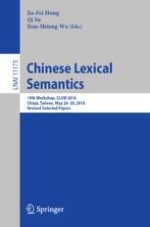2018 | OriginalPaper | Buchkapitel
Right Dislocation in Cantonese: An Emotion-Intensifying Device
verfasst von : Sophia Yat Mei Lee, Christy Choi Ting Lai
Erschienen in: Chinese Lexical Semantics
Aktivieren Sie unsere intelligente Suche, um passende Fachinhalte oder Patente zu finden.
Wählen Sie Textabschnitte aus um mit Künstlicher Intelligenz passenden Patente zu finden. powered by
Markieren Sie Textabschnitte, um KI-gestützt weitere passende Inhalte zu finden. powered by

 [The phenomenon of inversion (of sentence parts) in syntax of spoken Chinese]. Zhongguo yuwen (Chin. Lang. Writ.)
[The phenomenon of inversion (of sentence parts) in syntax of spoken Chinese]. Zhongguo yuwen (Chin. Lang. Writ.)  [On incremental sentences]. In: Yuwen, Z. (ed.) Academic Papers for Celebrating the 50th Anniversary of Zhongguo yuwen (Chinese Language and Writing), pp. 39–48. The Commercial Press, Beijing (2004)
[On incremental sentences]. In: Yuwen, Z. (ed.) Academic Papers for Celebrating the 50th Anniversary of Zhongguo yuwen (Chinese Language and Writing), pp. 39–48. The Commercial Press, Beijing (2004)
 [Studies in Chinese Functional Grammar]. Jiangxi Education Publishing House, Nanchang (1996)
[Studies in Chinese Functional Grammar]. Jiangxi Education Publishing House, Nanchang (1996)